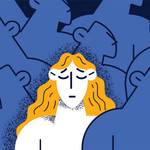New treatments for depression
Antidepressants do work. So do some surprising new depression treatments

Source: Best Health Magazine, September 2008
You’ve seen the news stories: “Antidepressants’ ‘little effect.’’” “New study says Prozac does not work.” These were just two of many headlines this spring when a pair of studies suggested antidepressants may not help the vast majority of depressed people. Yet those studies, in The New England Journal of Medicine (NEJM) and PLoS Medicine, actually found that antidepressants are better than placebos, especially the more depressed one is. They just don’t make that much of a difference (when compared to a placebo) for those with mild depression. For example, Erick Turner, an assistant professor at Oregon Health and Science University and an author of the NEJM study, clarifies that his research looked at a specific subset of negative trials, and that his findings don’t apply to the vast majority of clinical trials.
Antidepressants remain the best, most accessible treatment for the 1.5 million Canadians living with depression, says Dr. Anthony Levitt, psychiatrist-in-chief at Sunnybrook Health Sciences Centre and Women’s College Hospital in Toronto. Not only are antidepressants effective for 55 to 60 percent of first-time users, they can have some dramatic effects. Selective serotonin reuptake inhibitors (SSRIs), for example, significantly reduce death by suicide in those who are depressed, according to an analysis of 26 countries conducted by the U.S. National Bureau of Economic Research.
But there’s still room for improvement: Canadian and international researchers are working hard to develop even more effective antidepressant medications with fewer side effects, complementary non-medicinal therapies, and diagnostic tools that will enable doctors to deliver more targeted treatments based on the hormonal and genetic triggers of depression.
Making antidepressants better
All of the currently available antidepressants work equally well, statistically speaking, says Wende Wood, a psychiatric pharmacist with the Centre for Addiction and Mental Health (CAMH) in Toronto. The challenge is finding the right drug for the right individual, so it alleviates as many depression symptoms as possible with the fewest side effects. “Ninety-five percent of people will get it right by the sixth [medication they try],” adds Levitt.
That can make for a long and difficult trial-and-error period. Twenty percent of the initial 60 percent of successful first-time users will quit their first antidepressant because of side effects such as insomnia, dry mouth and sexual dysfunction. Likewise, going off one antidepressant to try another can trigger symptoms ranging from dizziness to fatigue. Doctors try to minimize these challenges by reviewing clinical practice guidelines and considering how different side effects might affect different depression symptoms, based on their own anecdotal experiences. For instance, Effexor, an SNRI (serotonin norepinephrine reuptake inhibitor), can cause agitation and insomnia, so it may not be ideal for someone experiencing sleeplessness and anxiety.
SNRIs are a newer class of antidepressants available to doctors, in addition to SSRIs, the most commonly prescribed antidepressants for the past 20 years. They both work in the same fashion: increasing levels of neurotransmitters believed to affect mood (such as serotonin and/or norepinephrine) by inhibiting their natural “reuptake,” or absorption by brain cells. SNRIs and SSRIs don’t work better than the older class of tricyclics popular in the 1980s, such as Elavil and Sinequan; they’re just better at targeting only the neurotransmitters involved in depression. That focus means they have fewer individual side effects.
New drugs to treat depression
New drugs that target more than just the different brain chemicals are being investigated. For example, researchers are examining the role that cortisol, a stress hormone, plays in depression. Hormones and brain chemicals affect each other back and forth, explains Wood. A drug that controls cortisol might alleviate symptoms of depression or, in a best-case scenario, prevent the condition from developing in the first place. “But it will be five years, at least, before we see any of this stuff make it to market,” says Wood.
Ketamine, used in anesthesia (in high doses), is also promising, says Dr. Husseini Manji, director of the mood and anxiety disorders program at the National Institute of Mental Health in Bethesda, Md. His study, published in General Psychiatry, found that participants who had failed on an average of six antidepressants experienced mood boosts as early as two hours after the first dose of ketamine. Thirty percent of patients enjoyed improved symptoms for up to one week after receiving that first dose.
The downside to ketamine is “dissociative symptoms,” feelings that you are not real or that the environment is not real (hence its popularity as a nightclub drug). So Manji and his team are doing clinical trials on NR2B antagonists, which deliver the same effects without dissociation. A new medication in pill form, riluzole, is also being studied. Another theoretical option would be to receive a ketamine injection in a hospital clinic, where side effects could be monitored. However, it will be a few years before any of this is available to the public.
Nerve growth factor (VGF)—small proteins that develop and maintain nerve cells—offer another potential drug-development target. “Injecting VGF produces similar behavioural effects as currently offered by antidepressants,” says Catharine Duman, an associate research scientist in the department of psychiatry at Yale University, who has conducted mouse studies. “It’s possible that VGF uses mechanisms that are more effective than those used by traditional anti-depressant drugs.” But more research is required on this and many other medications in development, which makes non-medicinal advances even more appealing.
Complementary therapies for depression
No one pill can solve depression altogether. Research suggests that talk therapy, meditation and exercise, including yoga, can all help. Moderate to vigorous exercise up to 30 minutes every day can alleviate symptoms. “For some people, medication is necessary to help them feel well enough to participate in other treatments,” says Wood. Choosing the right approach at the right time is key. For example, a patient could start talk therapy before the antidepressants even kick in, or try yoga a few months later.
Studies have proven that cognitive behaviour therapy or CBT (a form of talk therapy that teaches coping skills), for instance, often works better in combination with antidepressants than either treatment alone. Dr. Sidney Kennedy, psychiatrist-in-chief at the University Health Network in Toronto, recommends CBT, when available, with antidepressants for people with mild depression. However, CBT is neither widely accessible in Canada, nor is it covered by most workplace health plans.
Light therapy—exposure to daylight or specific wavelengths of full-spectrum light (which has long been used to treat seasonal affective disorder)—is also a promising adjunct for depression treatment. A study by the University of British Columbia Hospital showed that a light box worked just as well as fluoxetine (e.g., Prozac) for those with seasonal affective disorder. Light boxes or lamps are available in Canada, but patients are advised to use them, and any other complementary therapy, in consultation with their doctor.
New diagnostics, tailored treatments
A number of diagnostic tools are making it easier for doctors to peel back the mystery surrounding depression and help develop treatments that target specific genetic, environmental and biological triggers. For instance, simple blood tests conducted by a doctor can assess enzyme activity in the liver and determine whether someone is likely to experience more severe side effects on a specific antidepressant. “This would allow doctors to change the dose, spread it out further or switch to a medicine that does not metabolize that enzyme,” says Wood.
Magnetic resonance imaging (MRI) brain scans can also predict who will respond well to antidepressants to treat anxiety and who will not, say researchers at Dartmouth College in Hanover, N.H. And a California company, CNS Response, has developed a database of 2,500 patients’ referenced-electroencephalograms (rEEGs), which map out electrical activity in the brain and performance of certain medications. “Studies have shown a greater than 65 percent success rate in treating even the hardest-to-treat patients, according to rEEG reports,” says Dr. Mark Schiller, a psychiatrist in San Francisco and the company’s director of medical affairs, adding that that’s a 30 percent improvement over standard care. (At press time, the company’s website listed only one Canadian professional licensed to use rEEGs.)
Mapping genes associated with depression may also enable individualized treatments, based on its underlying biological cause. For example, among people with a variant of SLC6A4—a serotonin transporter gene—women were more likely than men to be susceptible to depression. “In the future, we hope to offer treatment based on a person’s specific biology,” says study co-author Dr. Tracy Gunter, an assistant professor of psychiatry at the University of Iowa.
Dr. Arturas Petronis, head of the Krembil Family Epigenetics Laboratory at CAMH in Toronto, says epigenetics—the study of factors that regulate our genes—is the field that holds the most promise for personalized depression treatments. It’s very difficult to change DNA sequence variations, but in future, medications specifically selected to treat an epigenetic defect could be used to fix the gene. This could eliminate depression rather than treat its symptoms, but a drug will be decades in the making, he says.
Still, it’s exciting to know these treatments are in development. Meanwhile, Wood says, depression sufferers can feel confident that, used properly, antidepressants are a very useful tool.
This article was originally titled "Down, But Not Out," in the September 2008 issue of Best Health Magazine. Subscribe today and never miss an issue!




